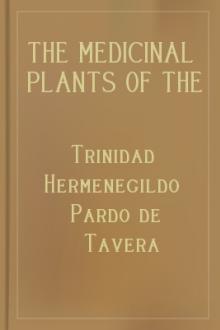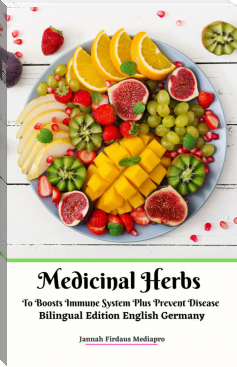The Medicinal Plants of the Philippines by Trinidad Hermenegildo Pardo de Tavera (best pdf ebook reader for android TXT) 📖

- Author: Trinidad Hermenegildo Pardo de Tavera
- Performer: -
Book online «The Medicinal Plants of the Philippines by Trinidad Hermenegildo Pardo de Tavera (best pdf ebook reader for android TXT) 📖». Author Trinidad Hermenegildo Pardo de Tavera
Habitat.—Visayan Islands.
Amaryllis Family.
Crinum Asiaticum, L. (C. giganteum, Blanco.)
Nom. Vulg.—Bakog̃, Tag.
Uses.—The decoction of the leaves is used in the Philippines as an expectorant. The plant is official in the Pharmacopœia of India as an emetic and in small doses is nauseant and diaphoretic. As an emetic the dose of the fresh juice of the root is 8–16 grams every 10 minutes till vomiting occurs. Dr. W. O’Shaughnessy, writing from Bengal, states that this is the only indigenous and abundant emetic plant of which he has experience, which acts without producing griping, purging, or other unpleasant symptoms. In a communication to Dr. Waring he remarks that it is a good emetic and diaphoretic whenever ipecacuanha is not at hand but that it should be regarded not so much as a substitute for that article as a resource in case of need.
The leaf juice is used in India to drop into the ears for disease of these organs.
One of the infinite remedies used by the Filipinos under the name of “contrapoisons,” without specifying or knowing what poison, is the powdered root of Crinum, given internally with a little water. They also use the leaves locally for the itch, bruising them and rubbing the affected parts energetically with them. I may note here in passing, what I have written before: that the Filipinos have from time immemorial been familiar with the sarcopt of scabies (Kahaw) which they pick out with a needle or spine of some fish or vegetable.
Botanical Description.—A plant with globose, scaly root. Leaves keeled or ridged. Flowers white, on a flattened stalk, on a spathe of 2 leaflets and several dry threads enclosing 4 flowerets. Corolla funnel-form, tube long and triangular; limb cut in 6 horizontal lanceolate lobes. Stamens 6, shorter than corolla. Anthers long. Stigma with 3 points. Seed vessel inferior, 3-celled, each cell containing a seed.
Habitat.—Very common on the seashore and in groves of mangrove trees. Blooms in July.
Lily Family.
Aloes Barbadensis, Mill. (A. humilis, Blanco; A. vera, L.; A. vulgaris, Banck.; A. Indica, Royl.)
Nom. Vulg.—Sabila, Tag.; Dilag̃ boaya, Vis.; Aloes, Eng.
Uses.—This species is one of those which produce the substance known in pharmacy as aloes, which is the juice of the leaf evaporated to the consistency of an extract. It is official in all pharmacopoeias and its properties are known to the Filipino herb-doctors. They use the fresh juice of the leaves as a stimulant of the scalp in baldness and locally in contusions. Aloes is a slow purgative and its irritating action on the lower portion of the large intestine extends to the genito-urinary organs. It is, therefore, an emmenagogue and its prolonged use causes hemorrhoids, especially in man. It is contraindicated where there is disease of the genito-urinary organs or rectum. As it increases the secretion of bile it is useful in certain hepatic diseases. It is used in small doses as a tonic in dyspepsia. The tonic dose is ½–20 centigrams; purgative, 15–50 of the extract, preferably in pill form. It is customary to associate it with other purgatives.
Botanical Description.—A stemless plant, the leaves springing immediately from the root as in the pineapple, joined at the base, straight, ligulate, very fleshy and becoming thinner toward the end, with stiff thorns along the edges. Flowers between yellow and red outside and straw-colored inside, in racemes on a cylindrical scape 3° or more high, sometimes ramose, peduncles very short. Corolla cylindrical, somewhat incurved, cleft to the middle in 6 parts, 3 external, acute and superposed on the others, obtuse at the apex and of different color. Stamens 6, inserted at the nectiferous base of the ovary and of the same length as the corolla. Anthers erect. Ovary cylindrical with 6 furrows. Stigma obtuse, with raveled edges. The seed vessel ovoid, 3-valved, 3-celled, with 2 seeds in each, furnished with 3 spongy wings.
Habitat.—Common in gardens.
Allium sativum, L.
Nom. Vulg.—Ajo, Sp.; Bawag̃, Tag.; Garlic, Eng.
Allium Cepa, L.
Nom. Vulg.—Cebolla, Sp.; Lasuna, Sibuyas, Tag.; Onion, Eng.
Uses.—The garlic and the onion are used to excess as condiments in Philippine as well as Spanish cooking. Both are difficult of digestion and communicate a very disagreeable odor to the breath, intolerable to those who are unaccustomed to it. Garlic possesses the singular property, familiar to many students and soldiers, of inducing a transient fever if introduced within the anus. When bruised and applied to the skin it has a counter-irritant action which makes it useful in the treatment of rheumatism, but the odor is so disagreeable that it is not worth while to use it for that purpose when we have so many other medicines which produce the same effect without being objectionable. It is also used locally for the bites of venomous animals.
The onion is used cooked as a poultice over the bladder and internally for various catarrhs. It is better to abstain from the therapeutic and culinary use of products so indigestible and so malodorous.
Botanical Description.—These plants are so well known in all parts of the world that a description of them would be superfluous.
Palm Family.
Areca Catechu, L.
Nom. Vulg.—Bog̃a, Tag.; Betel-nut Palm, Areca, Eng.
Uses.—The seeds form part of a masticatory very common throughout the extreme Orient, known as Buyo and composed of a betel leaf, a little slaked lime, and a slice of the fruit of the bonga, known as Siri in Indo-China and among the Malays. It is so common that it is hard to find a man or woman who does not use it. The saliva of those who use it is red and of a strong odor, and its careless use in time blackens the teeth and makes the breath extremely disagreeable. Habitual chewers consider it a tonic of the mouth and stomach and a general stimulant as well. It probably does possess these properties but they are reversed in the case of persons who use it immoderately for they lose appetite, become salivated, and the whole organism degenerates. The carbonized and powdered fruit is used as a dentifrice but its virtues are doubtless identical with those of any vegetable charcoal, i. e., absorbent and antiseptic.
One unaccustomed to the use of bonga and chewing it for the first time, usually experiences a most disagreeable combination of symptoms; constriction of the œsophagus, a sensation of heat in the head and face, the latter becoming red and congested; at the same time dizziness and precordial distress are experienced. The same phenomena occur in certain persons after eating palmito salad or the tender central portion of the bonga and of other palms.
The flowers are eaten in salad like the above-mentioned palmito. The seed is astringent and tænifuge; for the latter purpose it is given internally as a powder in a dose of from 16 to 24 grams. Its action is uncertain. The catechu which is obtained in India from the Bonga differs from that obtained from the Acacia Catechu and is a tonic analogous to rhatany and cinchona.
The seeds contain about 14% of a fatty crystalline material which melts at 39°, and after saponification yields a crystalline, fatty acid that may be regarded as a mixture of lauric and muriatic acids. They also contain about 14% of a red, amorphous tonic material which, after drying, is but slightly soluble in cold or hot water.
The lower part of the petiole of the leaves is thin and broad, ensheathing the trunk, is as tough as pasteboard when dry and is used in the Philippines as wrapping paper; Dr. Bholanauth Bose and other physicians of India use it as a material for splints in fractures, a practice which might well be imitated in Manila and especially in the country.
Botanical Description.—A well-known palm with slender stem, surrounded by many circles; it grows to about the same height as the coco-nut palm or less. The flowers spring in bunches of long, thread-like spikes from the trunk a little below the crown of leaves at the base of the long, smooth, green, sheath-like petioles which clasp the trunk; each spike bears many staminate and a few pistillate flowers. The fruit is about the size and shape of a hen’s egg, the husk tow-like or filamentose, the kernel pinkish or light red.
Habitat.—Grows throughout the islands.
Cocos nucifera, L.
Nom. Vulg.—Coco, Sp.-Fil.; Niog, Tag.; Coco-nut Palm, Eng.
Uses.—This plant is, perhaps, the most useful in the Philippines. Without it and the bamboo plant the people of the Archipelago would not know how to live. It produces vinegar, an alcoholic drink called tuba or coco-wine, an oil, an edible nut, and its leaves are used instead of nipa to roof the huts.
Tuba is an opaline, slightly sweet liquid, with an agreeable taste, which rapidly becomes acid under the influence of the heat. A flowering or fruit-bearing stalk, which has not been incised before, is chosen and encircled with several rings of rope or rattan. The stalk is then cut and a bamboo vessel called a bombón is hung to receive the sap which escapes during the night. This liquid is valuable as a drink for those who are debilitated, suffering from pulmonary catarrh, and even for consumptives, who are accustomed to drink it every morning, sometimes with marvelous results, according to reports. The heat of the day rapidly ferments the tuba, converting it into a mild vinegar, which is widely used for domestic purposes in the Philippines. When fermented and distilled it produces a weak alcohol of disagreeable taste called coco-wine.
The ripe fruit contains a rather soft and savory meat which is generally eaten mixed with the clear, sweet coco-nut milk. Later the meat becomes firmer and is used as a food and an oil much used in the islands is extracted from it. To extract the oil the meat is grated and pressed until all the juice is extracted. This is called the milk and when boiled is converted almost completely into oil. Cocoanut milk has an agreeable taste and may in some cases take the place of cow’s milk. It is apt to produce diarrhœa, however, which action may be bad for some but on the other hand good for others, such as the habitually constipated. Both the meat and the milk are widely used by the natives in making sweets.
In the greater part of the islands it is the only oil used for illumination. As a medicine it is employed internally as a purgative and externally in the treatment of scores of troubles in which the good results obtained are due, not to the oil but to the massage used in rubbing it in. It has the reputation of stimulating the growth of the hair and all the natives and some Europeans use it lavishly as a hair ointment. When fresh its odor is agreeable, but it easily becomes rancid and assumes a most disagreeable odor. In the Visayan Islands they make an oil of a nauseous odor which they call in Manila Caracoa. It is used only for illumination and by the poor.
At a temperature of 20° or more the oil remains liquid; it is colorless when fresh and properly extracted. It solidifies at 18° and two kinds of soap are made of it; one soft and exceedingly cheap called “Quiapo”; the other hard, white, of a high quality, but as a rule containing an excess of lime which in time is deposited in





Comments (0)